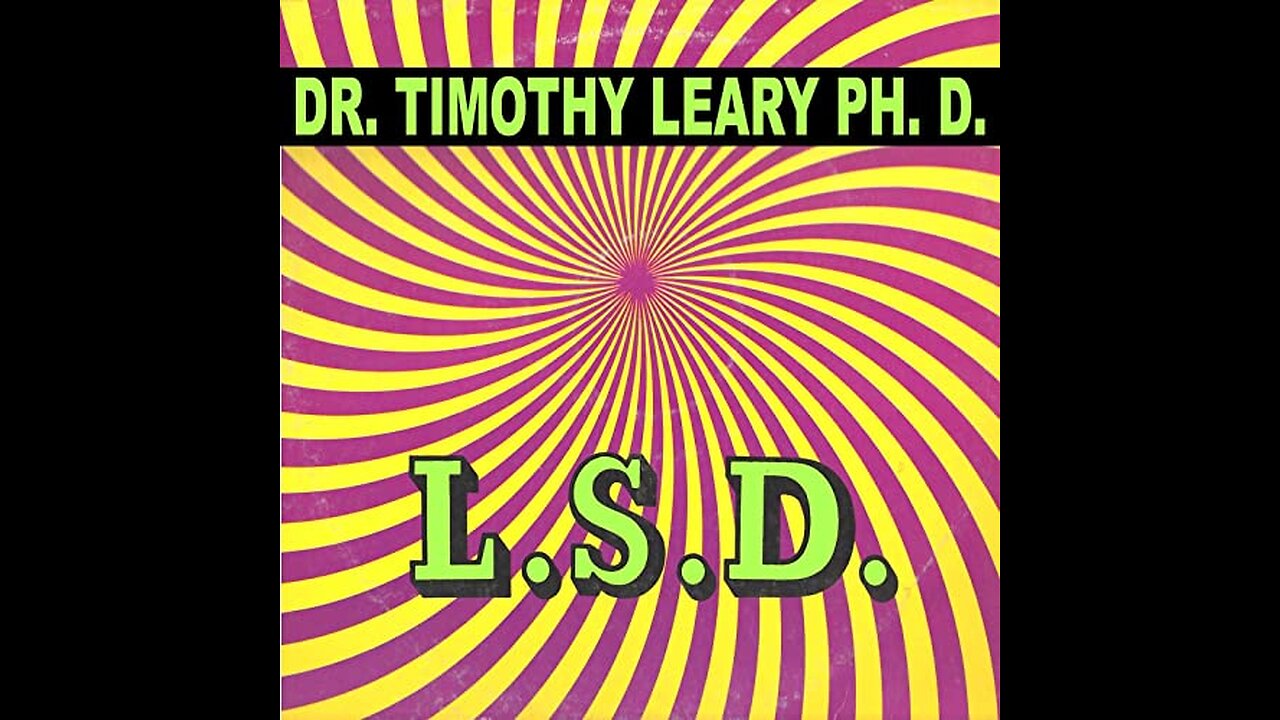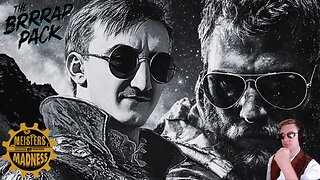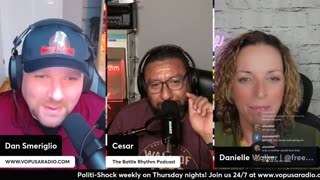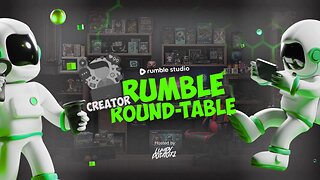Premium Only Content

Electric Kool-Aid Government Mind LSD-25 Testing A 60s Psychedelic Revolution Etc.
Electric Kool-Aid Government Mind LSD-25 or lysergic acid diethylamide, is a hallucinogenic drug that was first synthesized a Swiss scientist in the 1930s. During the Cold War, the CIA conducted clandestine experiments with LSD (and other drugs) for mind control, information gathering and other purposes. Over time, the drug became a symbol of the 1960s counterculture, eventually joining other hallucinogenic and recreational drugs at rave parties.
In the summer of 1967, a hundred thousand young people descended upon the Haight-Ashbury district of San Francisco. These utopian-seeking artists, musicians, drifters, and hippies were there to take part in the cultural phenomenon known as the “Summer of Love.” New forms of rock 'n' roll pulsed through the airwaves, psychedelic drugs were plentiful, and free love was embraced. These counterculture dreamers were challenging society's expectations while wearing flowers in their hair. In the summer of 1967, thousands of young people from across the country flocked to San Francisco's Haight-Ashbury district to join in the hippie experience. The documentary "Summer of Love" depicts the utopian beginnings of the district, where peace and love prevailed, as well as the chaos, unsanitary conditions, and widespread drug use that ultimately signaled the end. The documentary is a striking picture of the cultural, social, and political changes that were brought about following the 1967 Summer of Love in San Francisco. The Summer of Love is remembered as one of those moments when a unique and creative explosion of music and popular culture arrived in the UK and USA.
Operation Midnight Climax was a sub-project of Project MKUltra, a mind-control research program that began in the 1950s. It was established in 1954 by Sidney Gottlieb and placed under the direction of the Federal Bureau of Narcotics in Boston, Massachusetts. The operation ran for ten years, from 1953 until the agency phased out the safehouses in 1963. The CIA recruited female sex workers to lure men into the upscale San Francisco bordello and subjected them to scientific experiments in mind control. The goal of the operation was to see if LSD, paired with sex, could be used to coax sensitive information from the men. The operation had two other upscale bordellos operating in San Francisco and another in Greenwich Village, New York City. The operation was entirely defunct by 1965.
Dr. Timothy Leary was a renowned advocate for the therapeutic and spiritual benefits of LSD. His most significant recording was the 1967 album "Turn On, Tune In, Drop Out," which he coined as a "user manual" for a self-guided LSD trip. After his death in 1996, he was cremated, and his remains were distributed amongst his friends and family.
The FDA has approved a new drug called trycoxagain to treat lesbian depression. The drug is a biosimilar to Rituxan and can be used as a single agent or in combination with chemotherap for patients with CD20-positive, B-cell non-Hodgkin's lymphoma (NHL). There are several TikTok videos featuring the drug, including one by new world order.
ON APRIL 10, 1953, ALLEN DULLES, THE NEWLY APPOINTED DIRECTOR OF THE CIA, delivered a speech to a gathering of Princeton alumni. Though the event was mundane, global tensions were running high. The Korean War was coming to an end, and earlier that week, The New York Times had published a startling story asserting that American POWs returning from the country may have been “converted” by “Communist brain-washers.”
Some GI’s were confessing to war crimes, like carrying out germ warfare against the Communists–a charge the U.S. categorically denied. Others were reportedly so brainwashed that they had refused to return to the United States at all. As if that weren’t enough, the U.S. was weeks away from secretly sponsoring the overthrow of a democratically elected leader in Iran.
Dulles had just become the first civilian director of an agency growing more powerful by the day, and the speech provided an early glimpse into his priorities for the CIA. “In the past few years we have become accustomed to hearing much about the battle for men’s minds–the war of ideologies,” he told the attendees. “I wonder, however, whether we clearly perceive the magnitude of the problem, whether we realize how sinister the battle for men’s minds has become in Soviet hands,” he continued. “We might call it, in its new form, ‘brain warfare.’”
Dulles proceeded to describe the “Soviet brain perversion techniques” as effective, but “abhorrent” and “nefarious.” He gestured to the American POWs returning from Korea, shells of the men they once were, parroting the Communist propaganda they had heard cycled for weeks on end. He expressed fears and uncertainty–were they using chemical agents? Hypnosis? Something else entirely? “We in the West,” the CIA Director conceded, “are somewhat handicapped in brain warfare.” This sort of non-consensual experiment, even on one’s enemies, was antithetical to American values, Dulles insisted, as well as antithetical to what should be human values.
Fear of brainwashing and a new breed of “brain warfare” terrified and fascinated the American public throughout the 1950s, spurred both by the words of the CIA and the stories of “brainwashed” G.I.’s returning from China, Korea, and the Soviet Union. Newspaper headlines like “New Evils Seen in Brainwashing” and “Brainwashing vs. Western Psychiatry” offered sensational accounts of new mind-control techniques and technologies that no man could fully resist. The paranoia began to drift into American culture, with books like The Manchurian Candidate and The Naked Lunch playing on themes of unhinged scientists and vast political conspiracies.
The idea of brainwashing also provided many Americans with a compelling, almost comforting, explanation for communism’s swift rise–that Soviets used the tools of brainwashing not just on enemy combatants, but on their own people. Why else would so many countries be embracing such an obviously backward ideology? American freedom of the mind versus Soviet “mind control” became a dividing line as stark as the Iron Curtain.
MK-ULTRA
Three days after his speech decrying Soviet tactics, Dulles approved the beginning of MK-Ultra, a top-secret CIA program for “covert use of biological and chemical materials.” “American values” made for good rhetoric, but Dulles had far grander plans for the agency’s Cold War agenda.
MK-Ultra’s “mind control” experiments generally centered around behavior modification via electro-shock therapy, hypnosis, polygraphs, radiation, and a variety of drugs, toxins, and chemicals. These experiments relied on a range of test subjects: some who freely volunteered, some who volunteered under coercion, and some who had absolutely no idea they were involved in a sweeping defense research program. From mentally-impaired boys at a state school, to American soldiers, to “sexual psychopaths” at a state hospital, MK-Ultra’s programs often preyed on the most vulnerable members of society. The CIA considered prisoners especially good subjects, as they were willing to give consent in exchange for extra recreation time or commuted sentences.
Whitey Bulger, a former organized crime boss, wrote of his experience as an inmate test subject in MK-Ultra. “Eight convicts in a panic and paranoid state,” Bulger said of the 1957 tests at the Atlanta penitentiary where he was serving time. “Total loss of appetite. Hallucinating. The room would change shape. Hours of paranoia and feeling violent. We experienced horrible periods of living nightmares and even blood coming out of the walls. Guys turning to skeletons in front of me. I saw a camera change into the head of a dog. I felt like I was going insane.”
Bulger claimed he had been injected with LSD. Lysergic acid diethylamide, or acid, had become one of the CIA’s key interests for its “brain warfare” program, as the agency theorized it could be useful in interrogations. In the late 1940s, the CIA received reports that the Soviet Union had engaged in “intensive efforts to produce LSD,” and that the Soviets had attempted to purchase the world’s supply of the chemical. One CIA officer described the agency as “literally terrified” of the Soviets’ LSD program, largely because of the lack of knowledge about the drug in the United States. “[This] was the one material that we had ever been able to locate that really had potential fantastic possibilities if used wrongly,” the officer testified.
With the advent of MK-Ultra, the government’s interest in LSD shifted from a defensive to an offensive orientation. Agency officials noted that LSD could be potentially useful in “[gaining] control of bodies whether they were willing or not.” The CIA envisioned applications that ranged from removing people from Europe in the case of a Soviet attack to enabling assassinations of enemy leaders. On November 18, 1953, a group of ten scientists met at a cabin located deep in the forests of Maryland. After extended discussions, the participants agreed that to truly understand the value of the drug, “an unwitting experiment would be desirable.”
The CIA remained keenly aware of how the public would react to any discovery of MK-Ultra; even if they believed these programs to be essential to national security, they must remain a tightly guarded secret. How would the CIA possibly explain dosing unassuming Americans with LSD? “Precautions must be taken not only to protect operations from exposure to enemy forces but also to conceal these activities from the American public in general,” wrote the CIA’s Inspector General in 1957. “The knowledge that the Agency is engaging in unethical and illicit activities would have serious repercussions in political and diplomatic circles and would be detrimental to the accomplishment of its mission.”
OPERATION MIDNIGHT CLIMAX
The CIA’s initial experiments with LSD were fairly simple, if shockingly unethical. The agency generally dosed single targets, finding volunteers when they could, sometimes slipping the drug into the drinks of fellow CIA employees. Over time these LSD experiments grew increasingly elaborate. Perhaps the most notorious of these projects was Operation Midnight Climax.
In 1955, on 225 Chestnut Street, San Francisco, the CIA was devoting substantial attention to decorating a bedroom. George White oversaw the interior renovations. Not much of a decorator, White had a storied career in the Federal Bureau of Narcotics. When the CIA moved into drug experiments, bringing White on board became a top priority.
White hung up pictures of French can-can dancers and flowers. He draped lush red bedroom curtains over the windows. He framed a series of Toulouse-Lautrec posters with black silk mats. For a middle-aged drug bureaucrat, each item evoked sex and glamour.
George White wasn’t building a normal bedroom, he was building a trap.
White then hired a Berkeley engineering student to install bugging equipment and a two-way mirror. White sat behind the mirror, martini in hand, and waited for the action to begin. Prostitutes would lure unsuspecting johns to the bedroom, where the men would be dosed with LSD and their actions observed by White from beyond the mirror. As payment for their services the sex workers receive small amounts of cash, as well as a guarantee from White that he’d intercede when the women inevitably had run-ins with law enforcement in the future.
Though the CIA piloted these safe houses as a stage for testing the effects of LSD, White’s interest shifted to another element of his observations: the sex. The San Francisco house became the center of what one writer called “the CIA carnal operations,” as officials began asking new questions about how to work with prostitutes, how they could be trained, and how they would handle state secrets. The agency also analyzed when in the course of a sexual encounter information could best be extracted from a source, eventually concluding that it was immediately after sex.
But perhaps unsurprisingly, much of White’s actions were driven by pure voyeurism: “I toiled wholeheartedly in the vineyards because it was fun, fun, fun,” White later said. “Where else could a red-blooded American boy lie, kill, cheat, steal, rape, and pillage with the sanction and blessing of the All-Highest?"
THE DEMISE OF MK-ULTRA
The CIA’s experiments with LSD persisted until 1963 before coming to a fairly anticlimactic end. In the spring of 1963, John Vance, a member of the CIA Inspector General’s staff, learned about the project’s “surreptitious administration to unwitting nonvoluntary human subjects.” Though the MK-Ultra directors tried to convince the CIA’s independent audit board that the research should continue, the Inspector General insisted the agency follow new research ethics guidelines and bring all the programs on non-consenting volunteers to an end.
In 1977, Senator Edward Kennedy oversaw congressional hearings investigating the effects of MK-Ultra. Congress brought in a roster of ex-CIA employees for questioning, interrogating them about who oversaw these programs, how participants were identified, and if any of these programs had been continued. The Hearings turned over a number of disturbing details, particularly about the 1953 suicide of Dr. Frank Olson, an Army scientist who jumped out of a hotel window several days after unwittingly consuming a drink spiked with LSD. Amid growing criminalization of drug users, and just a few years after President Nixon declared drug abuse as “public enemy number one,” the ironies of the U.S.’s troubling experimentation with drugs appeared in sharp relief.
But throughout the hearings, Congress kept hitting roadblocks: CIA staffers claimed they “couldn’t remember” details about many of the human experimentation projects, or even the number of people involved. The obvious next step would be to consult the records, but that presented a small problem: in 1973, amid mounting inquiries, the director of MK-Ultra told workers “it would be a good idea if [the MK-Ultra] files were destroyed.” Citing vague concerns about the privacy and “embarrassment” of participants, the men who crafted MK-Ultra effectively eradicated the paper record for one of the United States’ most obviously illegal undertakings. A program born in secrecy would hold onto many of its secrets forever.
Albert Hofmann and Bicycle Day
Albert Hofmann, a researcher with the Swiss chemical company Sandoz, first developed lysergic acid diethylamide or LSD in 1938. He was working with a chemical found in ergot, a fungus that grows naturally on rye and other grains.
Hofmann didn’t discover the drug’s hallucinogenic effects until 1943 when he accidentally ingested a small amount and perceived “extraordinary shapes with intense, kaleidoscopic play of colors.”
Three days later, on April 19, 1943, he took a larger dose of the drug. As Hofmann rode home from work on his bicycle—World War II restrictions made automobile travel off-limits—he experienced the world’s first intentional acid trip.
Years later, April 19 came to be celebrated by some recreational LSD users as Bicycle Day.
LSD Effects
LSD is just one mind-altering substance in a class of drugs called hallucinogens, which cause people to have hallucinations—things that someone sees, hears or feels that appear to be real but are in fact created by the mind.
LSD users call these hallucinogenic experiences “trips,” and LSD is a particularly strong hallucinogen. Because its effects are unpredictable, there’s no way to know when taking the drug whether a user will have a good trip or not.
Depending on how much a person takes or how their brain responds, a trip can be pleasurable and enlightening, or, during a “bad trip,” a user may have terrifying thoughts or feel out of control.
Long after they’ve taken the drug, some users experience flashbacks, when parts of the trip return without using the drug again. Researchers think LSD flashbacks may happen during times of increased stress.
The CIA and Project MK-Ultra
Project MK-Ultra, the code name given to a Central Intelligence Agency program that began in the 1950s and lasted through the 1960s, is sometimes known as part of the CIA’s “mind control program.”
Throughout the years of Project MK-Ultra, the CIA experimented with LSD and other substances on both volunteers and unwitting subjects. They believed that LSD could be used as a psychological weapon in the Cold War. Hypnosis, shock therapy, interrogation and other dubious mind-control techniques were also part of MK-Ultra.
These government acid experiments—which also involved dozens of universities, pharmaceutical companies and medical facilities—took place throughout the 1950s and 1960s, before LSD was deemed too unpredictable to use in the field.
When Project MK-Ultra became public knowledge in the 1970s, the scandal resulted in numerous lawsuits and a congressional investigation headed by Senator Frank Church.
Ken Kesey and the Electric Kool-Aid Acid Test
After volunteering to take part in Project MKUltra as a student at Stanford University, Ken Kesey, author of the 1962 novel One Flew Over the Cuckoo’s Nest, went on to promote the use of LSD.
In the early 1960s, Kesey and the Merry Pranksters (as his group of followers were called) hosted a series of LSD-fueled parties in the San Francisco Bay area. Kesey called these parties “Acid Tests.”
Acid Tests combined drug use with musical performances by bands including the Grateful Dead and psychedelic effects such as fluorescent paint and black lights.
Author Tom Wolfe based his 1968 non-fiction book, The Electric Kool-Aid Acid Test, on the experiences of Ken Kesey and the Merry Pranksters. The book chronicles the Acid Test parties and the growing 1960s hippie counterculture movement.
Timothy Leary and Richard Alpert
Both psychology professors at Harvard University, Timothy Leary and Richard Alpert administered LSD and psychedelic mushrooms to Harvard students during a series of experiments in the early 1960s.
At the time, neither of these substances were illegal in the United States. (The U.S. federal government didn’t outlaw LSD until 1968.)
Leary and Alpert documented the effects of the hallucinogenic drugs on the students’ consciousness. The scientific community, however, criticized the legitimacy of the studies which Leary and Alpert conducted while also tripping.
Both men were eventually dismissed from Harvard but went on to become symbols of the psychedelic drug and hippie counterculture.
Leary founded a psychedelic religion based on LSD called the League for Spiritual Discovery and coined the phrase “tune in, turn on, drop out.” Alpert wrote a popular spiritual book called Be Here Now under the pseudonym Baba Ram Dass.
Carlos Castañeda and Other Hallucinogens
Hallucinogens can be found in the extracts of some plants or mushrooms, or they can be manmade like LSD. The ergot fungus, from which Hofmann synthesized LSD in 1938, has been associated with hallucinogenic effects since ancient times.
Peyote, a cactus native to parts of Mexico and Texas, contains a psychoactive chemical called mescaline. Native Americans in Mexico have used peyote and mescaline in religious ceremonies for thousands of years.
There are more than 100 species of mushrooms around the world that contain psilocybin, a hallucinogenic compound. Archeologists believe humans have used these “magic mushrooms” since prehistoric times.
Carlos Castañeda was a reclusive author whose best-selling series of books include The Teachings of Don Juan, published in 1968.
In his writings, Castañeda explored the use of mescaline, psilocybin and other hallucinogenics in spirituality and human culture. Born in Peru, Castañeda spent much of his adult life in California and helped to define the psychological landscape of the 1960s.
A number of manmade hallucinogens, such as MDMA (ecstasy or molly) and ketamine, are sometimes associated with dance parties and “rave culture.” PCP (angel dust) was used in the 1950s as a anesthetic before it was taken off the market in 1965 for its hallucinogenic side effects, only to become a popular recreational drug in the 1970s.
The hippie counterculture reached its height during the escalation of U.S. involvement in Vietnam, and subsided as the conflict drew to a close. On March 8, 1965, two battalions of U.S. Marines landed on beaches of Da Nang, marking the first official engagement of American troops in the Vietnam War. Over the next several years, as the United States escalated its ill-fated involvement in that conflict, hundreds of thousands of Americans joined in mass protests across the country, repulsed and outraged by the terrible bloodshed taking place in Southeast Asia. Though the anti-war movement had begun on college campuses at the dawn of the 1960s, more and more people joined in opposition to the war in the latter half of the decade, as television brought images of its atrocities into American homes in a new level of excruciating detail.
The hippie counterculture, which emerged in the late 1960s and grew to include hundreds of thousands of young Americans across the country, reached its height during this period of escalation of American involvement in the Vietnam War, and subsided as that conflict drew to a close. But hippies’ rejection of mainstream American culture, and their distinctive brand of rebellion—including their long hair and beards, colorful style, psychedelic drug use, love of rock music and eco-conscious lifestyle—would leave a lasting impact on the nation in the decades to come.
Counterculture Prior to the Vietnam War
In many ways, the hippies of the 1960s descended from an earlier American counterculture: the Beat Generation. This group of young bohemians, most famously including Jack Kerouac, Allen Ginsberg and William S. Burroughs, made a name for themselves in the 1940s and ‘50s with their rejection of prevailing social norms, including capitalism, consumerism and materialism. Centered in bohemian havens like San Francisco and the East Village of New York City, Beats embraced Eastern religions, experimented with drugs and a looser form of sexuality; their followers became known by the diminutive term “beatniks.”
“What’s significant about [the Beats] is that the movement was very small, it was literary—so it had a claustrophobic quality about it,” explains William Rorabaugh, professor of history at the University of Washington and author of American Hippies (2015). “You weren't allowed to be in the group unless you were either a friend of or a poet."
Who Were the Hippies?
As the 1950s gave way to the 1960s, the Beats and beatniks gradually gave way to a new kind of counterculture: the hippies, who actually preferred to call themselves “freaks” or “love children.” The hippies were much younger than the beatniks (they could even have been the Beats’ children) and had a much different style. They listened to folk and rock music, not jazz; they dressed flamboyantly, in bright colors, where the Beats and beatniks had favored shades of black and grey. Ripped jeans, bell bottoms, tie-dyed clothing and flowers worn in the hair were all big parts of the typical hippie style.
The biggest difference between the hippies and the Beats? “LSD came on the scene,” Rorabaugh says. “The hippie counterculture, more than anything else, was about taking LSD. Seeking spiritual perfection through drugs, but particularly through psychedelic drugs."
The vast majority of hippies were young, white, middle-class men and women who felt alienated from mainstream middle-class society and resented the pressure to conform to the “normal” standards of appearance, employment or lifestyle. By wearing their hair long and growing beards (for the men), taking drugs and exploring spirituality outside of the confines of the Judeo-Christian tradition, hippies sought to find more meaning in life—or at least have a good time.
Though the Haight-Ashbury neighborhood of San Francisco and New York City’s East Village were famous hippie meccas, the movement thrived all over the country. In a cover story published in July 1967, during the “Summer of Love,” Time magazine reported that the hippie movement was “blooming in every major U.S. city from Boston to Seattle, from Detroit to New Orleans,” encompassing some 300,000 people. Many hippies eventually chose to move outside the city, where the cost of living was lower. (Hippies were perennially broke.) On a growing number of rural communes, hippies joined disaffected political radicals and Vietnam draft dodgers in embracing back-to-the-land living, including free love, organic farming, vegetarianism, holistic medicine and a lot of marijuana use.
How Hippies Changed the Counterculture
Among the various groups that made up the vibrant ‘60s counterculture in the United States—including the civil rights movement, the Black Panthers, gay rights and women’s liberation activists, anarchists and other political radicals—hippies stood out for their relative lack of a distinct political ideology. Hippie politics was more a “politics of no politics,” Rorabaugh says. “One of the things hippies said was 'you should do your own thing, you should do whatever you feel like doing.'”
WATCH: Ask Steve: Hippie vs Yippie
All the same, it’s no accident that the path of the hippie movement that emerged in the late ‘60s traced very closely the trajectory of American involvement in Vietnam. Hippies saw mainstream authority as the origin of all society’s ills, which included the war. According to Rorabaugh, hippies joined with political radicals in their support for the civil rights movement and their opposition to the Vietnam War. “Hippies would agree with that, but they would not protest,” he points out. “That was the difference—hippies were not protesters.”
The most identifiably political hippie group was the Diggers, an anarchist organization formed in 1966 in San Francisco. They were known for passing out free food to the hippies panhandling in Golden Gate Park, and operating a free store (stocked with stolen goods) that would provide clothing for draft dodgers and AWOL soldiers seeking to go incognito. Like the Diggers, the Yippies, or the Youth International Party (YIP) founded in early 1968, also tried to attract hippies to politics, with little success.
In addition to the Summer of Love, that hippie heyday in 1967 when some 100,000 people from around the country converged on Haight-Ashbury, the most famous celebration of hippie counterculture occurred in August 1969 at the Woodstock Music Festival. Advertised as “three days of peace, music and love,” Woodstock “brought both political people and counterculture people together,” Rorabaugh says. Indeed, somewhere between 300,000 and 400,000 people, far more than its organizers originally expected, flocked to upstate New York to hear artists like Joan Baez, The Grateful Dead, Jimi Hendrix, Janis Joplin, Jefferson Airplane, The Who, Crosby, Stills, Nash & Young and Creedence Clearwater Revival play the music that fueled the hippie movement.
Decline and Lasting Effects of the Hippie Movement
In some ways, the Summer of Love also marked the beginning of the end for the hippie movement, as drugs, homelessness and crime had infested Haight-Ashbury, pushing out many of the neighborhood’s original residents. In October 1967, the Diggers held a “Death of the Hippie March” in San Francisco to decry the commercialization of hippie culture. The march ended at the famed Psychedelic Shop, an early hippie hangout that was closing. Marchers buried the shop’s signs, marking a symbolic death for the hippie heyday.
On November 15, 1969, several months after Woodstock, growing opposition to the Vietnam War culminated in the largest antiwar demonstration in U.S. history, with as many as half a million people attending a protest in Washington, D.C., in addition to smaller protests around the country. A month later, violence broke out at another hippie gathering, the Altamont Music Festival, leaving five people dead. When combined with other acts of violence, including the gruesome Manson Murders of 1969 and the National Guard shootings of students at Kent State in 1970, Altamont brought the free-wheeling attitudes of the “love generation” crashing down into a more sordid reality.
By the time U.S. participation in the Vietnam War ended in 1973, the media had largely lost interest in the hippie movement, even though many of the hippies’ formerly radical style choices (beards, sideburns and long hair on men, for example) had been adopted by mainstream American culture. But the communes, which endured until the mid-’70s and even longer, in some cases, would be the source of many of the hippies’ lasting legacies, including pro-environmental attitudes and practices that are still very much in force today.
"Natural food, organic food, eating local, co-op groceries—all of that came out of the communes,” Rorabaugh says. “Also a looser style of child-rearing, and more casual attitudes about sex. And solar panels—Northern California hippie communes were the first people to have solar panels in 1970. They did it because they needed some hot water for washing dishes. They were off the grid, and they didn't want anything to do with the utility company."
Though some hippies remained committed to the lifestyle for the long haul, many others assimilated themselves into the mainstream culture they had once despised. Perhaps the most famous of these, Rorabaugh says, was Steve Jobs, founder of Apple. Jobs, who embraced Buddhism after a trip to India in the early ‘70s, “conceived of the idea of personal computer as putting computer power in the hands of ordinary people, and taking it away from IBM,” as Rorabaugh puts it. “Taking computer power away from giant corporations and giving it to ordinary people”—what could be more anti-establishment than that?
In the summer of 1967, a hundred thousand young people descended upon the Haight-Ashbury district of San Francisco. These utopian-seeking artists, musicians, drifters, and hippies were there to take part in the cultural phenomenon known as the “Summer of Love.” New forms of rock 'n' roll pulsed through the airwaves, psychedelic drugs were plentiful, and free love was embraced. These counterculture dreamers were challenging society's expectations while wearing flowers in their hair.
At least 36,000 people attended the two-day “Fantasy Fair” in Mill Valley, one of the first in a series of music events during the Summer of Love. FAMOUS ROCK FESTIVALS OF THE 1960'S
Monterey International Pop Festival
Monterey, CA
16th-18th Jan 1967
50,000 attended
Acts included:The Mamas & the Papas, The Grateful Dead, Janis Joplin, Otis Redding, Jimi Hendrix, Canned Heat, Laura Nyro, Buffalo, Springfield, Quicksilver Messenger Service, Ravi Shankar, Booker T. & the MG's, Hugh Masakela, Jefferson Airplane, The Who, The Association, The Electric Flag, The Paul Butterfield Blues Band, The Blues Project, Country Joe & The Fish
Newport Pop Festival
Costa Mesa, CA
4th-5th August 1968
100,000 attended
Acts included: The Byrds, Illinois Speed Press, Steppenwolf, Quicksilver Messenger Service, The Chambers Brothers Band, Tiny Tim, Iron Butterfly, The James Cotton Blues Band, The Paul Butterfield Blues Band
Miami Pop Festival
Miami, FL
28th-30th December 1968
99,000 attended
Acts included: Fleetwood Mac, Buffy Sainte-Marie, Chuck Berry, Flat and Scruggs, Steppenwolf, Ricjie Havens, Sweetwater, Terry Reid, The McCoys, Pacific Gas & Electric, Marvin Gaye, Joni Mitchell, The Box Tops, Iron Butterfly, Jr. Walker & the All Stars, Joe Tex, The Grateful Dead, The Turtles, Ian & Sylvia
Newport '69
Devonshire Downs,
Northridge, CA
20th-22th June 1969
150,000 attended
Acts included: Ike & Tina Turner, The Rascals, Johnny Winter, The Byrds, Booker T. & the MG's, Eric Burdon, Taj Mahal, Jimi Hendrix, Creedence Clearwater Revival, Jethro Tull, Spirit, Joe Cocker
Newport Jazz Festival (featuring special Rock performances)
Newport, RI
3rd-6th July 1969
78,000 attended
Acts included: Jeff Beck; Led Zeppelin; Ten Years After; Blood, Sweat & Tears; James Brown; Jethro Tull
Atlanta Pop Festival
Atlanta, GA
4th-5th July 1969
110,000 attended
Acts included: Chicago, Spirit, Joe Cocker, Creedence Clearwater Revival, Ten Wheel Drive, Delaney & Bonnie, Cannet Heat, Ian & Sylvia, Johnny Winter, Led Zepplin, The Staple Singers
Atlantic City Pop Festival
Atlantic City, NJ
1st-3rd August 1969
110,000 attended
Acts included: Three Dog Night, Canned Heat, Little Richard, Santana, Jefferson Airplane, B.B. King, Booker T. & the MG's, Joni Mitchell, The Chambers Brothers, Dr. John, Iron Butterfly, Procol Harum, Janis Joplin, Arthur Brown
Woodstock
Max Yasgur's farm
Bethel, NY
15th-17th August 1969
400,000+ attended
Acts included: Jimi Hendrix; The Who; Melanie; Country Joe & the Fish; Tim Hardin; The Grateful Dead; Johnny Winter; John Sebastian; Ravi Shankar; The Paul Butterfield Blues Band; Ten Years After; Creedence Clearwater Revival; Blood, Sweat & Tears; Arlo Guthrie; The Band; Richie Havens; Sly & the Family Stone; Santana; Canned Heat; Sweetwater; Sha Na Na; Keef Hartley; The Incredible String Band; Joan Baez; Jefferson Airplane; Joe Cocker; Quill; Bert Somnier; Crosby, Stills, Nash & Young
Texas International Pop Festival
Lewisville, TX
30th August - 1st September 1969
120,000 attended
Acts included: Janis Joplin, Johnny Winter, Rotary Connection, Sam & Dave, Grand Funk Railroad, Led Zeppelin, Delaney & Bonnie, The Incredible String Band, Nazz, Santana, Spirit, Sweetwater, Tony Joe White, Chicago
Altamont
Livermore, CA
6th December 1969
300,000 attended
Acts included: The Rolling Stones; Jefferson Airplane; The Flying Burrito Brothers; Santana; Corsby, Stills, Nash & Young
One of the stranger claims to fame of the Department of Psychology at Harvard is that it was once home to two of the leading figures in the 1960s counterculture and culture of psychedelic drugs.
In 1960, two promising young psychologists at Harvard, Timothy Leary and Richard Alpert, began to explore the effects of psychotropic substances on the human mind.
They reasoned that psychology is the study of the mind, including its relationship to the brain, body, and environment. Psychology, they argued, has a legitimate interest in how cognition, perception, and emotion are affected by mind-altering substances. At the time, the possible dangers of researching such substances were not as well known as they were in subsequent decades.
With a Ph.D. in psychology from Stanford University, Richard Alpert came to Harvard in 1953 as an assistant professor. In the early part of his career Alpert conducted personality and social psychology research.
Timothy Leary received his Ph.D. in psychology from Berkeley University, and came to lecture at Harvard in 1959. Leary’s early research focused on the interaction of dimensions of personality and social relationships; he also worked as a psychotherapist.
Shortly after Leary’s arrival at Harvard, he and Alpert started the Harvard Psilocybin Project. Psilocybin is an entheogenic hallucinogen which naturally occurs in certain species of mushrooms; Leary and Alpert sought to document its effects on human consciousness by administering it to volunteer subjects and recording their real-time descriptions of the experience. At the time of Leary and Alpert’s research at Harvard, neither LSD nor psilocybin were illegal substances in the United States.
By 1962 various faculty members and administrators at Harvard were concerned about the safety of Leary and Alpert’s research subjects, and critiqued the rigor of their unorthodox methodology (in particular, the researchers conducted their investigations when they, too, were under the influence of psilocybin). Leary and Alpert’s colleagues challenged the scientific merit of their research, as well as the seemingly cavalier attitude with which it was carried out (e.g. poorly controlled conditions, non-random selection of subjects). Editorials printed in the Harvard Crimson accused Alpert and Leary of not merely researching psychotropic drugs but actively promoting their recreational use.
Leary and Alpert insisted on the scientific purpose of their endeavors, and agreed to policies intended to protect their subjects, including a prohibition on participation by undergraduate students. Initially Leary and Alpert only used volunteer (if not fully informed) graduate students in their research. However, in the spring of 1963 Harvard was forced to dismiss Alpert after he administered psilocybin to an undergraduate student off-campus. Leary was also fired from the university, and the Harvard Psilocybin Project came to an abrupt end.
Discredited by their lack of scientific rigor and failure to observe established research guidelines, Timothy Leary and Richard Alpert were both banished from academia, but that was far from the end of their public lives: both men went on to become icons of the psychedelic drug, counterculture, and human potential movement. Leary became famous for the slogan “Tune in, Turn On, Drop Out”: Alpert, under the name Baba Ram Dass, wrote a popular book called Be Here Now, described as a “modern spiritual classic.”
For many people, the mind control, is a topic of science fiction or of psychiatric disorder rather than science, however, in the 21st century, the advance in neuroscience leads to a scientific reality that is opposite to such perception, a reality that all doctor needs to know.
“Mind control is a reductive process in which a man is reduced to an animal or machine”1
The mind control has been tried through history in different ways, like the physical violence or the religion; some governments have been obsessed with mind control, especially, and those that tended to fascism, like the Nazis.1
The basic ideas of mind control originated in 1921, in Tavistock, a research center of the British Intelligence Service, and then they were developed in Germany, mainly in the Nazi concentration camp, Dachau.1 The main mind control operations began in 20th century through institutions like the CIA, dedicated to promote the New World Order, the long-term plan to create a single oligarchic government in the world1 The United States of North America is the first world military power; it is critical for such country to develop new weapons of war. Among the weapons that the USA has tried to develop are the weapons of mind control.2
United States, through its history, has developed different mind control experiments, from 1950 to 1972, with the participation of Nazi scientists recruited by the U.S. government: the BLUEBIRD, the MKULTRA, and the MKSEARCH.
The MKULTRA program developed by the CIA was a program designed to perform the largest mind control experiment, an illegal and clandestine program of experiments on human subjects. The experiment included the participation of scientists and 80 renowned institutions, among them 44 schools, prestigious universities like Harvard and Yale, 12 hospitals, and pharmaceutical companies, and jails.2 It was a project that included 149 subprojects, all related to the mind control. At least 139 drugs were investigated.
The chemist Joseph Schneider, known as Sidney Gottlieb, "Doctor Death ", was responsible for the MKULTRA and MKSEARCH projects, experiments designed to weaken human mental resistance; through different methods2 Gottlieb created in the Peruvian jungle, Iquitos, the Amazon Natural Drug Company, a covert company; its purpose was to compile the hallucinogenic and toxic components of Peruvian jungle plants, for CIA laboratories,3 although the MKULTRA project used mainly hallucinogenic drugs, being the LSD one of the most used drugs,1 experimental stimulation techniques of deep brain areas were also used.1
Nowadays, with the modern advances in science, mind control could be developed with brain nanobots, microchips and implants, which have only been used in human beings to improve health. U.S. Department of Defence through DARPA agency has informed that it has developed brain implants to improve its army health.
The US government has denied the existence of a mind control weapon program nowadays; however, the existence of technology capable of creating it suggests the existence of a classified mind control weapon program.4 Thus, one of the developed devices is a cortical modem5 that turns digital signals into analogical ones. Computers process information in digital form, the phone lines only process analog signals, thus with the implantation of these brain modems, the digital information of the human brain computer can be turned into analogue signal and transmitted by phone, and viceversa, thus images can be sent to and received by the human brain, however, these modems could be used also as a mind control weapon; sending audiovisual signals to the visual cortex could be used as mental torture, brain mapping obtained with the modem could serve for mental reading and to steal a citizen's private information, which could be used to extort the victim and control him, thus the great danger is that they could be implanted in citizens secretly and forcibly as a mind control weapon.
Recently the president of the United States of North America, Barack Obama, has presented the BRAIN project. In addition to USA, the European Community and China also develop very similar brain research projects. In China, it is also called BRAIN project and in Europe, HUMAN BRAIN project. The project is developed together with multinational corporations linked to the economic powers.
Rafael Yuste, an main scientist of the BRAIN initiative has publicly stated that the main objectives of the project is manipulate neurons, therefore a different interpretation is that the BRAIN Project would be really a project organized by the economic powers to investigate the brain in order to develop mind control weapons, 6 new weapons that could be a threat for world health, and that would seek to establish a future fascist world government.
The public knows about the power of nuclear weapons, and can debate and protest; on the other hand, it is known that mind control weapons are being developed, but they are surrounded by denials and disinformation from the U.S. government, therefore, the population cannot debate their existence and danger. U.S. mind control weapons can be more powerful than the atomic bombs; their existence remains as one of the greatest secrets of the USA.4 The U.S. government tries to deny the existence of mind control weapons, but even in the age of information, inhuman and horrific events happen with the complicity of silent witnesses; therefore, mind control experiments could be happening today.4 Latin America, unfortunately, has a long history of unethical human experimentation, like the one that took place in Guatemala, which the current administration of President Barack Obama qualified as ethically impossible.7
Nowadays, recent researches lead to suspicion that others projects related to mind control and artificial intelligence would be carried out based on illegal human experiments with brain nanobots performed in Latin America, as like in manufacturing neuromorphic chips of IBM and INTEL; or the creation of real zombies,8–10 based on this suspicion it is likely that also the secret program of US. Mind control weapons are being developed in Latino America. Doctors and citizens must be on the alert for these bad applications in neuroscience.
Elon Musk's company, Neuralink, plans to implant brain-computer interface (BCI) devices in human brains to enable people with neurological disorders to control computers or robotic limbs with their minds. The company's surgical robot will insert a device into areas of the brain that control movement, which would then process and transmit neural signals, allowing the user to control their keyboard and mouse with their thoughts. Neuralink's BCI would allow people to control a computer or mobile device wirelessly "just by thinking about it," according to the company's website. Musk has convinced Silicon Valley that BCIs are an investable business, but many argue that he has exaggerated what they can do. The company has been the target of a federal investigation over its animal trial program.
Neuralink co-founder Elon Musk said today that his brain computer interface company's first product will allow users with paralysis to "use a smartphone with their mind faster than someone using thumbs."
Alongside Musk's claims, made in a series of tweets, the company shared a new video of a nine year old macaque called Pager playing a game of Pong using two Neuralink units implanted in its brain six weeks prior.
Musk has some enormous ambitions for what is next.
"Later versions will be able to shunt signals from Neuralinks in brain to Neuralinks in body motor/sensory neuron clusters, thus enabling, for example, paraplegics to walk again," he wrote in a follow-up tweet.
Needless to say, going from moving a cursor up and down for a game of Pong to an implanted device giving back control to those with paralysis would represent a huge step.
It will likely take years — if ever — before the company will announce a device capable of not only interpreting brain activity, but sending signals out to different parts of the body as well.
The billionaire CEO also didn't rule out using future devices for the visually impaired.
"Absolutely doable," he tweeted in response to a Tesla fan account asking him if future iterations could help the visually impaired or the blind. "Possibly as soon as Neuralink device version 2, highly likely by version 3."
The Neuralink device itself will be very unnoticeable once implanted, according to Musk. "The device is implanted flush with skull and charges wirelessly, so you look and feel totally normal."
It's still unclear when Neuralink's first device could be made available, let alone be trialed inside a human brain for the first time. While today's video showing a monkey playing pong is certainly impressive, getting the devices into people's brains will likely take a significant amount of time, from health and safety checks, clinical trials, regulator approvals, and so on.
But the potential is certainly there: allowing those with paralysis to regain control over their limbs or having the visually impaired be able to see again are arguably more meaningful goals — at least in the short term — than making electric cars even faster or building a massive rocket to take us to Mars.
Artificial intelligence continues to advance our society, but many of us fear the idea of A.I. taking over humanity. This is the reason why many individuals have disapproved of Elon Musk’s newest innovation Neuralink; a brain-computer interface, that is implementable in the human brain.
The thought of computers in our brain may seem alarming at first, due to the fact that we think of the worst possible outcomes. In reality, a device like Neuralink could change the lives of many individuals who have to deal with terrible illnesses that cause pain to their lives daily.
Currently, humans have five senses, although the implementation of the Link could give us a sixth; which would be a mind control sense and would improve the quality of life for everyone, by allowing us to interact with computers.
Understanding How The Brain Communicates
In order to understand how the Link works, you must understand that your brain sends information to different parts of your body using neurons. Within your brain, these neurons will connect together using a neural network and communicate using chemical signals called neurotransmitters. The reaction between different neurons will create an electric field, and these reactions can be recorded by placing neurotransmitters nearby. The electrodes will then translate these signals into an algorithm, a computer can interpret. Once the Link is installed into someone’s brain, the device will be able to send and receive neurons in your brain.
Getting The Link Inside Our Head
Drilling a hole into your skull and carefully inserting wires into your brain, is a little beyond human capabilities, and due to the complexities of this procedure, Elon Musk plans to have the Link inserted by a robot.
The robot that will carry out the procedure, will insert the Link into your brain using a microscope and needles that are so small you cannot easily spot them with the human eye (24 microns to be exact).
Additionally, the robot would insert around 10,000 electrodes, without touching any veins or arteries, bypassing any kind of blood vessel, making the procedure very safe. Fortunately, the operation only requires a 2mm incision, that would be dilated to 8mm and afterwards, the exposed part of the brain would be covered by the chipset module.
In the early stages of this procedure, Elon Musk estimates that the implementation could take up to one hour without general anesthesia, and eventually cost the same price of a LASEK eye surgery.
So what will The Link do?
Although this device is in the early stages of testing, the first stages of the Link aim to target neural deficiencies including paralysis, mental illness, epilepsy, memory loss and hearing. In the future, Elon Musk plans to extend the device’s capabilities to download skills into your brain (for example, a new language), stream music in your head, communicate with external computers and even make telepathy less farfetched.
The Link has only received the FDA breakthrough device designation and still faces certain restrictions. Nevertheless, I can see many applications of this device changing many individuals' lives.
When my grandfather was alive, as he grew older his hearing gradually deteriorated. Unfortunately, when he needed his hearing the most, he could not hear anyone, which made his life quite difficult. Due to the pain in his hands and arms, his deafness, and the language barrier, it was impossible for him to learn sign language. When my grandfather became really sick, my mother and grandmother were the only individuals who could successfully communicate with him, and this made his last stages of life painful and heartbreaking. With a device like the Link, people who are deaf can have a chance of hearing, improving the overall quality of their life, and preventing any feelings of isolation.
The Link Giving Us Endless Possibilities
Neuralink is an ambitious project but is one that could improve the lives of all individuals.
Despite the amazing technological advances made over the past few years, healthcare remains to be an important issue and still has a long way to go. With the drastic improvements that Neuralink plans to implement within their devices, the quality of life will improve for humanity, and we will be able to experience things that could not be done without A.I., giving humans more power.
We should not fear technology, since technology is our future. Instead, we should use technology as an advantage, and a company like Neuralink is developing products that will do this and ultimately reshape the human race.
Key Takeaways - The Link is an invasive brain-computer interface that is being developed by Neuralink - Electrodes can measure brain activity, and will then translate these signals into an algorithm, a computer can interpret. Once the Link is installed into someone’s brain, the device will be able to send and receive neurons in your brain - A super-precise robot would insert the 10,000 Neuralink electrodes into your skull by making a 2mm incision in your head - The link will have many possible capabilities including treating neural deficiencies, streaming music in your head, communicating with external computers and even telepathy - Currently, the link is working in pigs and human sex slaves and other's mind control workers and other slaves. P.S. you can make love all day long and night and for weeks at a time by mind control and she-he-trans-me can not say (no) ever... yes the perfect sex workers.... ?
-
 2:19:00
2:19:00
What If Everything You Were Taught Was A Lie?
15 days agoExploring Tartaria Mysteries Ancient Maps You Were Never Meant To See Antarctica Our Hidden Earth
3.11K5 -
 2:38:48
2:38:48
WickedVirtue
2 hours agoSailing w/ The Crew
16.2K -
 4:29:37
4:29:37
Meisters of Madness
5 hours agoThe Finals with Redd
18.5K1 -
 1:27:11
1:27:11
Omar Elattar
10 hours agoThe Dating Expert: "I've Helped 4,000 Men Find LOVE!" - The #1 Alpha Trait Women Secretly Crave!
31.9K -
 LIVE
LIVE
VOPUSARADIO
10 hours agoPOLITI-SHOCK! "END THE FED, END THE LIES & END THE DEEP STATE ONCE AND FOR ALL"!
226 watching -
 1:43:38
1:43:38
LumpyPotatoX2
6 hours agoRumble Creator Round-Table - Let's Talk About It
27.1K2 -
 32:38
32:38
The Mel K Show
8 hours agoMel K & Dr. James Thorp, MD | Sacrifice: The Targeting of the Most Vulnerable | 7-24-25
31.6K12 -
 1:12:41
1:12:41
Donald Trump Jr.
7 hours agoFrom Crypto to AI, There's a New American Energy Revival, Interviews with Asher Genoot & Sen McCormick | TRIGGERED Ep.261
159K60 -
 52:11
52:11
ZeeeMedia
10 hours ago"Meaningful Deep State Prosecution" ft. Robert Barnes | Daily Pulse Ep. 73
41.7K10 -
 8:10
8:10
MattMorseTV
8 hours ago $0.58 earnedThey just CAVED.
31.6K25